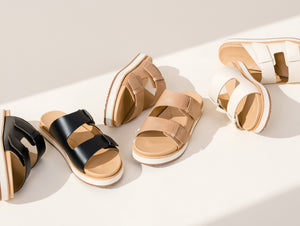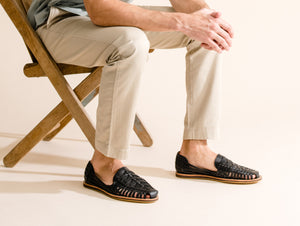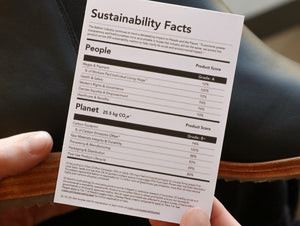Our Lowest Wage & The Lowest Wage Challenge
Part 1:
While we are thankfully starting to see a lot of talk about the serious ways that the fashion industry is failing our planet, the impact the industry is having on people has taken a dangerous back seat. We don’t believe these have to be mutually exclusive, and the time is now to shed further light on the serious social injustices going on within the industry.
It is estimated that less than 2% of the people who make the clothes on our bodies earn a living wage (Source: The True Cost). This means an estimated 98% of workers in the fashion industry are likely being held in systemic poverty and cannot meet their most basic needs. And, 75% of these workers are women between the ages of 18 and 24 (Source: Fashion Revolution, 2017).
This is not a small problem. In fact, the fashion industry employs 75 Million factory workers around the world (that’s a higher number than the population of over 220 different countries) (Source: Fashion United, 2017). Factoring in that many workers have children, the number of people this problem affects quickly becomes as large as the population of the United States, the 3rd largest country in the world.
Our industry’s negligence to provide a living wage is especially concerning when considering that the United Nations has declared it a basic human right.
“Everyone who works has the right to just and favorable remuneration ensuring for himself and his family an existence worthy of human dignity...”
(Source: Universal Declaration of Human Rights. Article 23.)
Unfortunately, all of this means that the products we enjoy most–your favorite pair of jeans, your go-to pair of shoes, that first outfit worn when the laundry is done–were likely made by people who are unable to meet the basic needs of themselves and their children.
5 ways brands are actively dodging responsibility for living wages:
All of this might be a surprise to you, but it may not be a surprise to the vast majority of brands that made the clothes you’re wearing right now. Many have known about insufficient wages (and the generational poverty that stems from these wages) for decades and are still doing very little about it. According to the Clean Clothes Campaign, 85% of large fast fashion brands surveyed in a 2014 study said that wages should be enough to meet workers’ basic needs. In 2019, however, none of these brands could demonstrate that any workers outside of their corporate headquarter countries were being paid a living wage (Source: Clean Clothes Campaign, 2019). There were also zero clear, time-bound plans for how a living wage would eventually be paid in supplier networks. Sadly, inaction by brands continually holds true throughout most of the fashion industry.
Rather than sharing in the responsibility of living wages within their supply chains, here are five ways that major fashion brands are actively dodging responsibility today:
- Brands dodge responsibility by saying they pay “the legal minimum wage.” However, minimum wages in many manufacturing countries within the fashion industry are only half of what would be considered a living wage (Source: Global Fashion Agenda, 2017). Brands choose not to address this fact and instead avoid the problem they are contributing toward by putting forth an unjust argument.
- Brands dodge responsibility by claiming living wages are too costly. Some brands claim that paying workers a living wage is too difficult from an expense perspective, but that’s not entirely true. Studies show that it would only cost a brand 1-4% more per garment to ensure living wages across their supply chain (Source: Oxfam, 2019).
- Brands dodge responsibility by saying the factory is responsible, not them. In many cases, brands shift the responsibility of ensuring a living wage to the manufacturer from whom they purchase. The problem with this logic is that those same brands are using their purchasing power to demand an extremely low cost from factories for the products they buy. And, the factories know there is always a threat that major brands will leave if they try to raise prices in order to pay workers more. A poignant real-life example of this appears in The True Cost (a groundbreaking documentary available on most streaming services) where a factory owner in Bangladesh explains–in intense tears–this sad reality.
- Brands dodge responsibility by saying workers are responsible. In other cases, major brands put the responsibility ON THE WORKERS themselves, claiming that “collective bargaining” and the right to create unions is the #1 protection of living wages. The problem with this logic? The reality is that workers are often threatened with losing their jobs when wages are challenged, and in some cases, even physically beaten by management. Again, hear the stories of real life garment industry workers in The True Cost, and you’ll quickly see how little power workers often have behind closed doors thousands of miles away from the final destination of our clothing.
- Brands dodge responsibility by saying living wages are too hard to calculate. Brands claiming that providing a living wage is not possible because living wages are difficult to calculate is a sad excuse. While they may not be perfect, living wage global benchmarks such as WageIndicator and Trading Economics are widely available (and MIT publishes a public database that shares what a living wage is in every county of the U.S.). On top of using these resources, brands can simply ask their workers what their living expenses are and establish the lowest wage based on those figures. Nisolo and ABLE have done this in many of their factories and have used affordable 3rd party auditor, ACCOUNTABLE to verify living wages. Sadly, most brands are not using these resources to improve the wages they pay their factory workers.
Livia Firth, Cofounder of Eco-Age and long-time living wage advocate, says it perfectly:
“Lack of clarity or consensus on precisely how a living wage should be calculated cannot be a legitimate justification for paying wages that on NO calculation could be said to constitute a living wage...there are numerous studies that have dealt with this issue on a country by country basis and these studies have been published for decades.”
(Source: The Circle. The Fundamental Fight to a Living Wage, 2017).
Enough is enough. It’s time for brands to stop dodging responsibility. Instead, we’re calling on all brands to vulnerably lean in and share their lowest wages and how they compare to living wages where they operate.
At the expense of human dignity and wellbeing, brands are not improving their practices fast enough. This must change. And, we believe this can change within our lifetime. While the industry is far from this reality today, we believe the fashion industry has the potential to serve as one of the most powerful conduits for social and environmental progress.
We envision a fashion industry in which every worker receives a living wage that covers their most basic needs. What would our world would look like if the 75 million people (and their children) held in poverty in the fashion industry were empowered out of poverty by receiving living wages for making the clothes we wear every day?
Part 2:
Living wages in the fashion industry today.
Above, we covered some of the major problems with wages in the fashion industry. We shared how it’s estimated that less than 2% of the 75 million people working to make the clothes we put on our bodies every day earn a living wage that covers their most basic needs. We shared how major brands are not taking responsibility for the roles they play in contributing to this problem. And, we shared how the incredibly slow rate at which improvement around wages is occurring is coming at the expense of human dignity and wellbeing. And finally, we shared how we envision a fashion industry in which everyone receives a living wage.
The truth is this is a complex journey that will take time. However, we believe there are clear, critical next steps brands and consumers can take to begin to transform the industry at an unprecedented rate. To summarize what you’ll read below, brands should publish and 3rd party verify their lowest wages (which Nisolo has now done!), and consumers should begin demanding that brands share their lowest wages.
Publishing lowest wages is a critical step toward living wages.
In order to accelerate the journey toward more prevalent living wages, much greater transparency around wages is fundamental. And, there is no wage that is more telling than the lowest wage–not the average wage, not the “labor cost” within a product–but the lowest wage.
For better or for worse, consumers often applaud brands for their transparency when brands share things like the “average wage” in their factories or the “labor cost” that went into making a garment. The problem with both of these metrics is that they often take into account the profitable markup that a factory takes and workers never touch. Or, they’ll take into account the wages of administration and executive staff of factory groups. When it can take a factory worker 1.5 years to earn what a large fashion brand CEO can make on their lunch break, you begin to see how sharing such metrics is not necessarily that transparent and certainly does not always achieve an objective of protecting workers (Source: Fashion Revolution, 2017).
In contrast, determining the lowest wage and how far it is from a living wage changes everything. Knowing the lowest wage establishes a critical baseline and helps us understand whether or not the wages of brands and factories are on a trajectory toward living wages. Therefore, by identifying and openly sharing the lowest wage, brands take the first step toward protecting the most vulnerable workers and everyone else in their supply chains as well.
One of our closest competitors, ABLE, pioneered this thought around the importance of the lowest wage when they published the lowest wage of their Nashville, TN offices in October of 2018. Exactly one year later, just as ABLE geared up to publish the lowest wages of their factories in Ethiopia, we partnered with them to share the lowest wages in our supply chain as well. While it may take time before a large quantity of brands follow our lead, every great movement begins with a small minority challenging injustice and standing up for what's right.
Our history with living wages and the lowest wage in our factory in Peru.
We have strived to pay a living wage to those working in our supply chain since inception. This was a huge part of why we started Nisolo in the first place. In our factory in Peru where a significant share of our products are manufactured, we’ve measured our producers’ expenses (by way of internal impact assessments) to ensure we provide a living wage that meets the actual needs of our shoemakers and their children since 2014. We do this by asking our shoemakers themselves how much they pay for housing, food, education, healthcare, utilities, transportation, clothing, and other essential needs (for them as individuals and for their children). This is one way we calculate a raw, living wage calculation. We also rely on 3rd party research from WageIndicator, a well-respected organization that collects wage data from around the world to evaluate the cost of a decent standard of living in our producers’ community. Based on our primary and secondary research calculations, we determined the latest living wage to be $269 a month. And, we set our lowest wage at $276 a month to ensure our producers could afford to meet their needs.
For local context, apart from providing a consistent, stable job (something that can be hard to come by in Trujillo, Peru), this $276 goes a long way for the vast majority of our shoemakers. On average, $276 per month has meant a 47% increase in the earnings of team members working at the Nisolo factory vs. their earnings prior to joining our team. And, as a reminder, this is the lowest wage in the factory and is for entry-level positions. For those who have worked with our team to strengthen their skill sets and have been at the factory for 3+ years, the average income increase is 152% higher than what they were previously earning outside of the Nisolo factory. For global context, $276 per month is significantly higher than the wages of the vast majority of factory workers in the footwear industry worldwide and 51% higher than the minimum wage in China, where most footwear manufacturing occurs (Source: The Circle. The Fundamental Right to a Living Wage, 2017).
3rd party verification and where we learned we were wrong in Peru.
Many of the stats we just shared are from internal, Nisolo-led social impact assessments. We take this work very seriously and try our best to adapt state of the art methodology on a regular basis. However, we’ve made plenty of mistakes in the past. And, apart from its crucial role in pure accountability and the fight toward honest transparency in the industry, this is one reason we are firm believers in the importance of 3rd party verification.
As sustainable fashion becomes more and more on-trend and marketable, there has never been a time in history when 3rd party verification has been more critical than it is today. Both for accountability as well as for the learnings 3rd party verifications offer, this is why we chose to become B Corporation certified in 2017. Seeking to learn more, we decided to hire ACCOUNTABLE this year to do an in-depth evaluation of our factory’s wages and working conditions.
Created in partnership with ABLE and GoodOps, a supply chain consulting group, ACCOUNTABLE is a social impact assessment platform that ensures worker protection while giving customers a transparent look at the good and bad that exists within factories. The assessment evaluates wages, equality, and safety, weighing a manufacturer’s score most heavily on paying a living wage, which is calculated by looking at a combination of the leading industry standards—WageIndicator and Trading Economics—local cost of living data, and survey data conducted by ACCOUNTABLE from the actual producers working in the factory. Based on those data points, the living wage is determined by working with partners in the local community and the auditor on the ground. Elements of ACCOUNTABLE’s living wage include nutrient-rich food, water, housing, education, healthcare, transportation, childcare, clothing, other essential needs, and savings for unexpected events.
We learned a lot from this audit and are excited to share more, but one of the most important learnings was that the living wage (reminder “living wage” roughly means the cost to meet a worker’s basic needs) we calculated internally of $269 was lower than the $280 living wage ACCOUNTABLE concluded from their findings. And, our lowest wage of $276 was $4 shy and 1.4% off from the living wage findings of ACCOUNTABLE’s audit.
We were wrong. Once we discovered this wage gap, we immediately worked with our team to raise our lowest wage to $280 a month, thereby ensuring all of our producers’ ability to earn a 3rd party verified living wage. We raised our lowest wages again in 2022 to $299.30 a month to account for inflation. In regards to our factory’s health and safety, an additional important learning was that we need to be more diligent with our factory’s 2nd and 3rd tier suppliers. We’ve since established a supplier Code of Conduct and will continue to monitor the social and environmental practices of the suppliers our factory uses to source materials. Our goal is to push them toward living wages as well.
What about the rest of our supply chain?
Nisolo currently operates across four countries, including the U.S., Peru, Mexico, and Kenya. We are on a journey toward ensuring that the lowest wages everywhere we operate are 3rd party verified living wages. We are not there yet, but here’s what we know thus far:
In the U.S., thankfully Massachusetts Institute of Technology (MIT) offers sound living wage data for every county in the country. In Nashville, where our headquarters, retail store, and distribution center are located, we learned that our lowest wage was not considered a living wage (once commissions and bonuses were taken out). When we referenced MIT’s research and saw that a living wage for a single individual in Nashville is $11.73 an hour, we raised our lowest wage from $10 an hour to $12 an hour for all of our current and future team members. Since initially publishing this post, we increased our wages in Nashville on three separate occasions. In 2020, we raised our lowest wage from $12 an hour to $12.40 an hour to meet MIT’s updated living wage. In 2021, when the living wage increased to $14.84 an hour, we increased our lowest wage from $12.40 an hour to $15 an hour, and in 2022, when the living wage increased to $17.68 an hour, we increased our lowest wage to $17.68 an hour, demonstrating the power of tracking and adjusting wages according to a 3rd party standard to ensure living wages.
In Mexico, the lowest wage across our three partner factories when we launched the Lowest Wage Challenge was $226.16 per month, which, according to WageIndicator’s living wage methodology and research, was technically a living wage in this area. In 2021, the lowest wage across our partner factories was $224.18, which continued to be a living wage according to WageIndicator’s research. The reason for this YOY decrease is because of fluctuating international exchange rates. Our lowest wage has actually increased in local currency and no worker has received less in the local currency, as this change is in relation to exchange rate only converting to USD. In 2022, our lowest wage in Mexico increased to $263.31 a month.
In rural Kenya, where our jewelry is made in partnership with independent artisans, the lowest wage paid has increased from $163.90 a month to $188.20 a month. According to our internal impact assessments (based on interviews about living expenses with the artisans themselves), $188.20 is higher than the living wage and is also in line with WageIndicator research for rural Kenya.
In Brazil, at the factory where we make our knit sneakers, the lowest wage is $347.30 a month, which is a living wage according to WageIndicator’s research.
While we have put a lot of time and research into the remainder of our supply chain outside of Peru, these figures have not yet been 3rd party verified by organizations apart from government agencies. Taking a stand for accountability in the industry and all that 3rd party verification can teach you, we are planning to pursue 3rd party verification throughout the remainder of our supply chain.
Because of the ways we have seen firsthand countless times how receiving a living wage can completely transform the wellbeing of entire families, our hope is that one day, all brands will openly share the lowest wages within their factories and begin working toward making them 3rd party verified living wages.
YOU are the critical piece for righting what’s wrong in the industry today.
Nisolo and ABLE are two brands out of thousands and thousands operating in the fashion industry. Obviously, we hope other brands will follow our lead and begin to share their lowest wages on the path toward providing living wages. However, from a basic economics standpoint, Supply (that is, the industry naturally moving in the direction of living wages) will never fix itself. Rather, Demand must outpace and drive Supply forward. Put simply, unless consumers begin to step up and demand through their words and purchases a faster shift toward living wages from the brands they love, this change will continue to happen far too slowly at the expense of human dignity and wellbeing.
A perfect and important example in the fashion industry of Demand pushing Supply forward at an unprecedented rate occurred not long ago. Child labor remained rampant throughout the fashion industry in the 1980s and 1990s despite the efforts of governments, NGOs, and certain brands to combat it. When consumers became aware after photos and videos emerged of children making clothes for major brands in the mid-1990s, consumers took to the streets demanding change and child labor rates curbed dramatically. Child labor in the fashion industry is still undoubtedly an issue, yet, since the 2000s, child labor has been cut down by another 38% (Source: International Labour Organization, 2017). While there is crucial work still to be done relating to child labor, the fashion industry today is light years away from the 1980s and 1990s in large part because consumers demanded this change and the supply chain responded accordingly.
A fashion industry where an estimated 98% of workers are unable to meet their most basic needs is unacceptable. Governments, NGOs, and brands have been talking in circles about this for too long now, and change is once again occurring far too slowly. The time has come for this generation of consumers to demand more from the industry for the sake of millions of people and their families.
Before we share a call to action, let’s pause and ensure we’re not getting lost in the numbers of this issue–75 million people and only 2% earn enough to cover their basic needs. These numbers are astounding on their own, but let’s bring them to life. There are real people with names and homes and families behind these numbers, and they likely made the clothing you are wearing right now. With 75% of them being women, let’s ask a different way: Is she safe from physical and sexual harm because of the stability of her job? Is she earning enough to put food on the table? Can she send her children to school, deterring generational poverty? Is she free to dream? Brands publishing their lowest wages is the first step of many to ensuring a “yes” to these questions, as it lays the baseline foundation for providing a living wage to everyone in the fashion industry’s supply chain.
To accelerate the shift toward living wages, we are partnering with our competitor, ABLE, to co-launch a movement that makes next steps for consumers and brands as seamless and straightforward as possible.
It’s called the #LowestWageChallenge, and this movement depends on you asking other brands outside of Nisolo and ABLE to share their lowest wages. Here is where you can learn more, and here is where you can take action.
It's time to shake up the industry and challenge the status quo.
Part 3:
Last year we shared some key stats to shed light on widespread, serious injustices against factory workers in the fashion industry:
- It is estimated that less than 2% of the people who make the clothes on our bodies earn a living wage (Source: The True Cost, 2015).
- This means that 98% of workers in the fashion industry are likely being held in systemic poverty and cannot meet their most basic needs.
- 75% of these workers are women between the ages of 18 and 24 (Source: Fashion Revolution, 2017).
Yet, brands are often applauded for their transparency when they share the ‘labor costs’ or the ‘average wage’ in their factories. What’s the problem with this? 93% of brands do not pay living wages capable of covering the basic needs of factory workers (Source: Clean Clothes Campaign, 2020). Sharing vague ‘labor costs’ or “average wages’ are better for marketing than they are for improving the plight of factory workers. In contrast, publishing your ‘lowest wage’ and comparing that to the ‘living wage’ where you manufacture establishes a critical baseline and takes the first step toward protecting the most vulnerable workers.
In November of 2019, along with publishing the lowest wages throughout our supply chain, we launched the Lowest Wage Challenge with ABLE, a fellow Nashville-based fashion brand. The challenge is simple: encouraging consumers to ask their favorite brands to share their lowest wages so that we can work together to move the fashion industry toward embracing living wages that cover the basic needs of the people who make the clothes we wear every day. Over the first few months of the Lowest Wage Challenge, you, our followers, stepped up big.
Thousands of nominations were submitted, calling on 566 different brands to publish their lowest wages, and dozens of brands—large and small—expressed interest in participating.
Just as we were gearing up to announce participating brands and exponentially grow the Lowest Wage Challenge, COVID-19 struck, shutting down the economy and leaving fashion brands and supply chains scrambling. While sales took a huge hit overnight, so did the fate of factory workers. With stay at home orders and the closing of retail stores around the world, brands suspended and canceled over $40 Billion worth of purchase orders. This left factories with no choice but to lay off millions of workers, most of whom were young women with young children and no safety net or other livelihood options.
Ultimately, the pandemic has spotlighted the fragility of our current fashion system and is requiring us to reimagine and revolutionize the way we produce and consume our clothes.
Where do we go from here?
Guaranteeing living wages for everyone in the supply chain of the fashion industry is certainly a marathon, not a sprint. The Lowest Wage Challenge remains an invitation for brands to take the first step toward letting go of the facade of perfection and instead stepping into greater transparency. While the Lowest Wage Challenge is perhaps needed now more than ever, given that so many brands have been forced to shift focus toward survival this year and consumers have been pulled toward many other just causes in society, we have decided to delay the expansion of the Lowest Wage Challenge and announcement of additional brands’ participation until a later date.
In the meantime, please help us continue building momentum for the Lowest Wage Challenge by asking your favorite brands to participate and sharing the below video with your friends and family.
Thank you for your ongoing support and dedication toward building a better fashion industry. See you next year.
Patrick Woodyard
Nisolo Founder & CEO




























